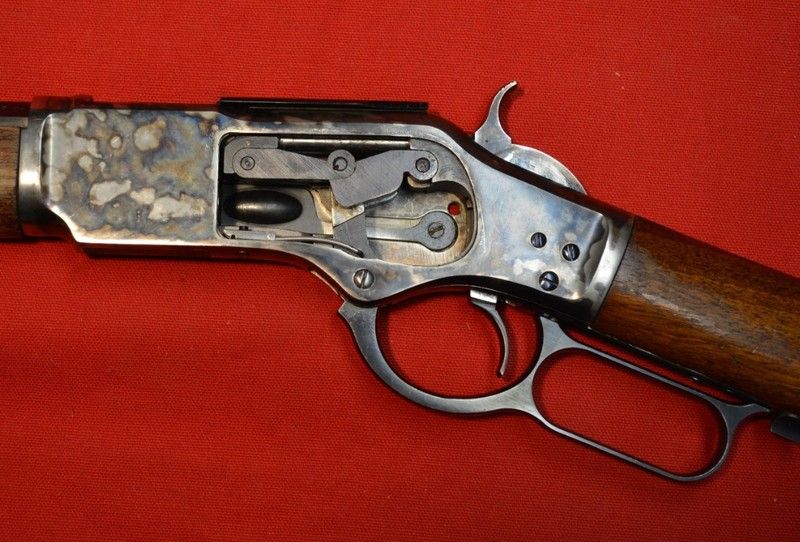stubbicatt
New member
For some strange reason I have been eyeballing Uberti 1873 clones. I've seen a couple at local gun stores, watched Hickok45 videos on youtube, and read what I could about them. Few days ago I was all set to buy the version I wanted in 45 Colt, when I learned that perhaps I should instead go 44-40, as it was a cartridge more suitable for black powder, were I to choose to use that propellant.
My uses are simply plinking, perhaps shoot the thing on steel to 200 or 300 yards. Actually, I have no use for one at all other than the joy of shooting it. I flirted with the idea of cowboy action shooting, but watching those videos left me cold. (Meh).
The rifles come in two general configurations, one with a straight grip stock, perhaps checkered, perhaps not, and a pistol grip stock of sorts with checkering on it and the fore end. I gravitate towards the pistol grip version, except one can see light between the lever and the bottom tang which leads me to believe that Uberti uses the same lever on both versions, which gap I find a little bit unsightly.
Question 1 is, in use, is there any advantage or disadvantage to the pistol grip?
The action lever must be closed and compressed by the firing hand with what seems to me to be unnecessary grip strength in order to discharge the weapon. There is a plunger of sorts protruding from the bottom tang behind the trigger which engages with the lever in order to assure that the action is fully closed before the rifle will allow the hammer to fall.
Question 2 is, is there a way to reduce the amount of tension one must use to grip the lever against that plunger? Perhaps a lighter spring or something? Does the rifle get a little bit easier in this grip strength issue as it is used a bit, and breaks in with use?
My eyes aren't what they were once, and I can barely make out the front sight post on the rifle. I have visited Uberti's website and note that they have available tang sights for this rifle. They offer at least 2 which are suitable. Apparently one would require drilling and tapping of a second hole on the upper tang, which near as I can tell, the other affixes simply with the single hole already in place which holds the butt stock to the tang.
Question 3 is, do both of these tang sights hold zero ok, and which of them do you recommend and why?
Question 4 is, is there any advantage to a larger aperture disc on the top of the tang sight? I gotta say that the Lyman style aperture with the peep in that small diameter rod looks like it could really put someone's eye out..
Lastly any other general words of advice you care to share?
Thanks gents for your helpful contributions.
PS. I still haven't decided on which cartridge, but I am leaning towards 44-40.
My uses are simply plinking, perhaps shoot the thing on steel to 200 or 300 yards. Actually, I have no use for one at all other than the joy of shooting it. I flirted with the idea of cowboy action shooting, but watching those videos left me cold. (Meh).
The rifles come in two general configurations, one with a straight grip stock, perhaps checkered, perhaps not, and a pistol grip stock of sorts with checkering on it and the fore end. I gravitate towards the pistol grip version, except one can see light between the lever and the bottom tang which leads me to believe that Uberti uses the same lever on both versions, which gap I find a little bit unsightly.
Question 1 is, in use, is there any advantage or disadvantage to the pistol grip?
The action lever must be closed and compressed by the firing hand with what seems to me to be unnecessary grip strength in order to discharge the weapon. There is a plunger of sorts protruding from the bottom tang behind the trigger which engages with the lever in order to assure that the action is fully closed before the rifle will allow the hammer to fall.
Question 2 is, is there a way to reduce the amount of tension one must use to grip the lever against that plunger? Perhaps a lighter spring or something? Does the rifle get a little bit easier in this grip strength issue as it is used a bit, and breaks in with use?
My eyes aren't what they were once, and I can barely make out the front sight post on the rifle. I have visited Uberti's website and note that they have available tang sights for this rifle. They offer at least 2 which are suitable. Apparently one would require drilling and tapping of a second hole on the upper tang, which near as I can tell, the other affixes simply with the single hole already in place which holds the butt stock to the tang.
Question 3 is, do both of these tang sights hold zero ok, and which of them do you recommend and why?
Question 4 is, is there any advantage to a larger aperture disc on the top of the tang sight? I gotta say that the Lyman style aperture with the peep in that small diameter rod looks like it could really put someone's eye out..
Lastly any other general words of advice you care to share?
Thanks gents for your helpful contributions.
PS. I still haven't decided on which cartridge, but I am leaning towards 44-40.
Last edited:






